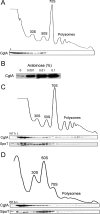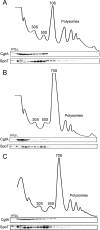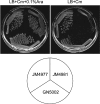G-protein control of the ribosome-associated stress response protein SpoT
- PMID: 17616600
- PMCID: PMC1951942
- DOI: 10.1128/JB.00315-07
G-protein control of the ribosome-associated stress response protein SpoT
Abstract
The bacterial response to stress is controlled by two proteins, RelA and SpoT. RelA generates the alarmone (p)ppGpp under amino acid starvation, whereas SpoT is responsible for (p)ppGpp hydrolysis and for synthesis of (p)ppGpp under a variety of cellular stress conditions. It is widely accepted that RelA is associated with translating ribosomes. The cellular location of SpoT, however, has been controversial. SpoT physically interacts with the ribosome-associated GTPase CgtA, and we show here that, under an optimized salt condition, SpoT is also associated with a pre-50S particle. Analysis of spoT and cgtA mutants and strains overexpressing CgtA suggests that the ribosome associations of SpoT and CgtA are mutually independent. The steady-state level of (p)ppGpp is increased in a cgtA mutant, but the accumulation of (p)ppGpp during amino acid starvation is not affected, providing strong evidence that CgtA regulates the (p)ppGpp level during exponential growth but not during the stringent response. We show that CgtA is not associated with pre-50S particles during amino acid starvation, indicating that under these conditions in which (p)ppGpp accumulates, CgtA is not bound either to the pre-50S particle or to SpoT. We propose that, in addition to its role as a 50S assembly factor, CgtA promotes SpoT (p)ppGpp degradation activity on the ribosome and that the loss of CgtA from the ribosome is necessary for maximal (p)ppGpp accumulation under stress conditions. Intriguingly, we found that in the absence of spoT and relA, cgtA is still an essential gene in Escherichia coli.
Figures






Similar articles
-
The Escherichia coli GTPase CgtAE cofractionates with the 50S ribosomal subunit and interacts with SpoT, a ppGpp synthetase/hydrolase.J Bacteriol. 2004 Aug;186(16):5249-57. doi: 10.1128/JB.186.16.5249-5257.2004. J Bacteriol. 2004. PMID: 15292126 Free PMC article.
-
The Escherichia coli GTPase CgtAE is involved in late steps of large ribosome assembly.J Bacteriol. 2006 Oct;188(19):6757-70. doi: 10.1128/JB.00444-06. J Bacteriol. 2006. PMID: 16980477 Free PMC article.
-
Regulation of the stringent response is the essential function of the conserved bacterial G protein CgtA in Vibrio cholerae.Proc Natl Acad Sci U S A. 2007 Mar 13;104(11):4636-41. doi: 10.1073/pnas.0611650104. Epub 2007 Mar 5. Proc Natl Acad Sci U S A. 2007. PMID: 17360576 Free PMC article.
-
Signalling by the global regulatory molecule ppGpp in bacteria and chloroplasts of land plants.Plant Biol (Stuttg). 2011 Sep;13(5):699-709. doi: 10.1111/j.1438-8677.2011.00484.x. Epub 2011 May 31. Plant Biol (Stuttg). 2011. PMID: 21815973 Review.
-
New horizons for (p)ppGpp in bacterial and plant physiology.Trends Microbiol. 2006 Jan;14(1):45-54. doi: 10.1016/j.tim.2005.11.006. Epub 2005 Dec 15. Trends Microbiol. 2006. PMID: 16343907 Review.
Cited by
-
Knockdown Experiment Reveals an Essential GTPase CgtA's Involvement in Growth, Viability, Motility, Morphology, and Persister Phenotypes in Vibrio cholerae.Microbiol Spectr. 2023 Mar 14;11(2):e0318122. doi: 10.1128/spectrum.03181-22. Online ahead of print. Microbiol Spectr. 2023. PMID: 36916969 Free PMC article.
-
Biochemical and physiological characterization of the GTP-binding protein Obg of Mycobacterium tuberculosis.BMC Microbiol. 2011 Feb 25;11:43. doi: 10.1186/1471-2180-11-43. BMC Microbiol. 2011. PMID: 21352546 Free PMC article.
-
Novel rRNA transcriptional activity of NhaR revealed by its growth recovery for the bipA-deleted Escherichia coli at low temperature.Front Mol Biosci. 2023 Apr 20;10:1175889. doi: 10.3389/fmolb.2023.1175889. eCollection 2023. Front Mol Biosci. 2023. PMID: 37152896 Free PMC article.
-
Bacterial lifestyle shapes stringent response activation.Trends Microbiol. 2013 Apr;21(4):174-80. doi: 10.1016/j.tim.2013.01.002. Epub 2013 Feb 16. Trends Microbiol. 2013. PMID: 23419217 Free PMC article. Review.
-
Systematic production of inactivating and non-inactivating suppressor mutations at the relA locus that compensate the detrimental effects of complete spot loss and affect glycogen content in Escherichia coli.PLoS One. 2014 Sep 4;9(9):e106938. doi: 10.1371/journal.pone.0106938. eCollection 2014. PLoS One. 2014. PMID: 25188023 Free PMC article.
References
-
- Blattner, F. R., G. Plunkett III, C. A. Bloch, N. T. Perna, V. Burland, M. Riley, J. Collado-Vides, J. D. Glasner, C. K. Rode, G. F. Mayhew, J. Gregor, N. W. Davis, H. A. Kirkpatrick, M. A. Goeden, D. J. Rose, B. Mau, and Y. Shao. 1997. The complete genome sequence of Escherichia coli K-12. Science 277:1453-1474. - PubMed
-
- Buglino, J., V. Shen, P. Hakimian, and C. D. Lima. 2002. Structural and biochemical analysis of the Obg GTP binding protein. Structure 10:1581-1592. - PubMed
-
- Butland, G., J. M. Peregrin-Alvarez, J. Li, W. Yang, X. Yang, V. Canadien, A. Starostine, D. Richards, B. Beattie, N. Krogan, M. Davey, J. Parkinson, J. Greenblatt, and A. Emili. 2005. Interaction network containing conserved and essential protein complexes in Escherichia coli. Nature 433:531-537. - PubMed
-
- Cashel, M., D. Gentry, V. J. Hernandez, and D. Vinella. 1996. The stringent response, p. 1488-1496. In F. C. Neidhardt, R. Curtis, J. L. Ingraham, E. C. C. Lin, K. B. Low, B. Magasanik, W. S. Reznikoff, M. Riley, M. Schaechter, and H. E. Umbarger (ed.), Escherichia coli and Salmonella: cellular and molecular biology, 2nd ed., vol. 1. ASM Press, Washington, DC.
Publication types
MeSH terms
Substances
LinkOut - more resources
Full Text Sources
Molecular Biology Databases

